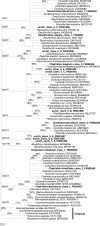Hitherto unknown [Fe-Fe]-hydrogenase gene diversity in anaerobes and anoxic enrichments from a moderately acidic fen
- PMID: 20118375
- PMCID: PMC2838027
- DOI: 10.1128/AEM.02895-09
Hitherto unknown [Fe-Fe]-hydrogenase gene diversity in anaerobes and anoxic enrichments from a moderately acidic fen
Abstract
Newly designed primers for [Fe-Fe]-hydrogenases indicated that (i) fermenters, acetogens, and undefined species in a fen harbor hitherto unknown hydrogenases and (ii) Clostridium- and Thermosinus-related primary fermenters, as well as secondary fermenters related to sulfate or iron reducers might be responsible for hydrogen production in the fen. Comparative analysis of [Fe-Fe]-hydrogenase and 16S rRNA gene-based phylogenies indicated the presence of homologous multiple hydrogenases per organism and inconsistencies between 16S rRNA gene- and [Fe-Fe]-hydrogenase-based phylogenies, necessitating appropriate qualification of [Fe-Fe]-hydrogenase gene data for diversity analyses.
Figures



References
-
- Bomar, M., H. Hippe, and B. Schink. 1991. Lithotrophic growth and hydrogen metabolism. FEMS Micriobiol. Lett. 83:347-350. - PubMed
-
- Carepo, M., J. F. Baptista, A. Pamplona, G. Fauque, J. J. G. Moura, and M. A. M. Reis. 2002. Hydrogen metabolism in Desulfovibrio desulfuricans strain New Jersey (NCIMB 8313)—comparative study with D. vulgaris and D. gigas species. Anaerobe 8:325-332. - PubMed
Publication types
MeSH terms
Substances
Associated data
- Actions
- Actions
- Actions
- Actions
- Actions
- Actions
- Actions
- Actions
- Actions
- Actions
- Actions
- Actions
- Actions
- Actions
- Actions
- Actions
- Actions
- Actions
LinkOut - more resources
Full Text Sources
Molecular Biology Databases

